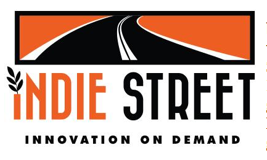By Jay Webb
Previously: Post #1: Introducing “Group” Distribution
A problem with our construction: Our street must be built on the active tectonic plates known as the Film-Tech Fault.
So how do we build a film/tech company when the dimensions & planes are constantly shifting?

Technology has quickly changed the content delivery and content consumption methods of indie film and many other industries. The issue with rapidly changing technologies is that none can say that these methods will not change again in the near future. There is a part of me that believes that the current growth rate in technology is completely unsustainable and may burst in a more traumatic way than the real estate bubble did, but this is a “blog” post on the “Internet”, so I we are surely not driven by fear of the unknown.
Technology or no technology, story telling effects all of mankind and it is the crux of what drives our passion at IndieStreet. The talented independent filmmaking story-tellers of our generation have this new technology & access at their finger tips; they must take advantage of the tech driven opportunities if they want to continue to make films and a fair living doing so.
I am thankfully slightly less confused than my cartoon self above, but it is true that building a street across a fault line is a daunting proposition. Here are some thoughts on navigating the emerging tech/content world and our thought process that went into some start-up decisions. IndieStreet has its own philosophies, but the more things change, the more interesting and plausible answers will arise from emerging great minds.
1. Ever changing technology & time to market
There are so many schools of thought on the time to market dilemma…Many intelligent individuals of the world just make it simple and decide to stay out of technology when it comes to choosing a primary business. Why invest so much time and money into technology development when you may not be able to be first to market, and furthermore may be obsolete in a stressfully short amount of time. These people are smarter and richer than I, but avoiding challenging situations is not my strong suit. Pressures on tech companies are borderline unfair, but they have chosen their bed in a house built along the fault line. So, with the looming pressures and rapid pace of technology, why did the IndieStreet partners (mostly filmmakers) decide to step into this unforgiving world??
The answer to the “why invest in technology” question is different for every company. For us, it was all about vertical integration and trying to give our own productions, and other content creators that we love, as much control over the marketing and financial instruments within their film’s distribution. I have a few personal horror stories about sub-distributors and foreign sales agents that are far too familiar to many Indie filmmakers. At the end of the day, we felt we needed to include a distribution outlet for our productions, and the most sensible future placement for our genre/style of films is the streaming market. We will still dabble in theatrical releases and have some nice premieres, but we foresee home theaters becoming a new version of the “big screen” for 2 dimensional character films at some point, and we have to be prepared. IndieStreet as a brand will be dedicated to its film productions in its initial years, and the value of the distribution platform proved to outweigh the costs even if we did not acquire a single other film to distribute. These calculations also helped us in developing our goals and standards for curating the IndieStreet library.
So in short, the IndieStreet plan for navigating this crazy, ever-changing landscape is to focus on production and the careful acquisition of truly unique and innovative content while doing the best we can to keep up with the Jones’s on cool technology advances. As long as a company has great product, there are always solutions that can be developed around new technology to deliver it to customers.
2. To curate or not to curate – that is the question.
Modern web consumers are content addicts, so how do you find your correct balance between quantity and quality as a content provider?
 While there are many successful companies that have content flowing out of every seem and this is becoming a new expectation, it is my personal opinion that the future of content consumption will lie at least partially in the hands of companies that filter the mountains of content into targeted collections. Even the biggest Facebook users and YouTube fanatics are beginning to feel overwhelmed with content overload. These companies do a decent job at allowing users to subscribe to channels, follow certain people, etc., but none of these large sites offer a significant monetizing solution for legitimate Indie filmmakers. There are surely nice self-distribution streaming options on the rise, but these are mostly all-accepting or large scale and do not make it easy for a general consumer to sort through the heap. Credible independent filmmakers do not have a very viable channel to self-distribute their films within a library that is curated for targeted customers: Film consumers who do not want to search forever for films that reach their specific standards in story, innovation, & quality. We hope IndieStreet and others to follow will help fill this gap between filmmakers and these picky & busy consumers.
While there are many successful companies that have content flowing out of every seem and this is becoming a new expectation, it is my personal opinion that the future of content consumption will lie at least partially in the hands of companies that filter the mountains of content into targeted collections. Even the biggest Facebook users and YouTube fanatics are beginning to feel overwhelmed with content overload. These companies do a decent job at allowing users to subscribe to channels, follow certain people, etc., but none of these large sites offer a significant monetizing solution for legitimate Indie filmmakers. There are surely nice self-distribution streaming options on the rise, but these are mostly all-accepting or large scale and do not make it easy for a general consumer to sort through the heap. Credible independent filmmakers do not have a very viable channel to self-distribute their films within a library that is curated for targeted customers: Film consumers who do not want to search forever for films that reach their specific standards in story, innovation, & quality. We hope IndieStreet and others to follow will help fill this gap between filmmakers and these picky & busy consumers.
After the Ted Hope / Jay Webb two-syllable name energy collided on a stimulating phone call, the IndieStreet team began to reach a middle ground that addressed the need for some perpetual content. We came to the conclusion that if IndieStreet wanted to be highly selective with film content, then we would need to have some further content flow for our supporters and customers. So, one of our street’s content driven suspension braces atop the Film-Tech fault will be “IndieStreet TV”. Far from a full-fledged TV network, IndieStreet TV will consist of a few weekly discussions, short films, and 1 weekly installment of an episodic series. We have the equipment and we love to write and create, so why not solve the content/engagement dilemma by having fun with a few simple but high-quality programs, 1 panel about things we want to talk about anyway (will be titled the namesake of this Hopeforfilm blog series “Word on the Street”), and one fun series that we want to produce anyway (this one is going to be a surprise!). This will keep our customers sufficiently engaged without overflowing them with content just for the sake of it. And if any of our feature film content contributors want to add to the content machine with quality episodic material or shorts, it gives us room to grow laterally.
Speaking of growing laterally, it’s time for a snack. Take a break and reward yourself with a sandwich for challenging your attention span and reaching the end of this post. Then get back to working on something that you love.
Next Up: Post # 3: Indieconomies of Scale: Cooperate or else!
Jay Webb – Jay Webb is an independent film producer/writer and small business entrepreneur who has discovered through trial by fire that it is literally impossible for him to choose personal capitalism over passion. Always balancing a life on both sides of the tracks, he has discovered that helping good people succeed (success=happiness) is the core of what drives him. The IndieStreet direct & “group distribution” film initiative is his personal Autobahn.
Web: IndieStreet.com
Twitter: @indiest_films





